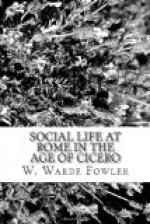It may be, indeed, that in quiet country districts the joyous rural festivals went on—we have many allusions and a few descriptions of them in the literature of the Augustan period,—and also the worship of the household deities, in which there perhaps survived a feeling of pietas more nearly akin to what we call religious feeling than in any of the cults (sacra publica) undertaken by the State for the people. Even in the city the cult of the dead, or what may perhaps be better called the religious attention paid to their resting-places, and the religious ceremonies attending birth, puberty, and marriage, were kept up as matters of form and custom among the upper and wealthier classes. But the great mass of the population of Rome, we may be almost sure, knew nothing of these rites; the poor man, for example, could no more afford a tomb for himself than a house, and his body was thrown into some puticulus or common burying-place,[531] where it was impossible that any yearly ceremonies could be performed to his memory, even if any one cared to do so. And among the higher strata of society, outside of these sacra privata, carelessness and negligence of the old State cults were steadily on the increase. Neither Cicero nor any of his contemporaries but Varro has anything to tell us of their details, and the decay had gone so far that Varro himself knew little or nothing about many of the deities of the old religious calendar,[532] or of the ways in which they had at one time been worshipped. Vesta, with her simple cult and her virgin priestesses, was almost the only deity who was not either forgotten or metamorphosed in one way or another under the influence of Greek literature and mythology; Vesta was too well recognised as a symbol of the State’s vitality to be subject to neglect like other and less significant cults. The old sacrificing priesthoods, such as the Fratres Arvales and the lesser Flamines, seem not to have been filled up by the pontifices whose duty it was to do so: and the Flamen Dialis, the priest of Jupiter himself, is not heard of from 89 to 11 B.C., when he appears again as a part of the Augustan religious restoration. The explanation is probably that these offices could not be held together with any secular one which might take the holder away from Rome; and as every man of good family had business




